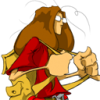2d platformer level design.
I have made 0 platform games, so I wouldn't be more experienced, but it seems to me you need some sort of difficulty level that increases in some way.
Difficulties come in all shapes and sizes, some first shots:
- More tricky jumps to reach some part of the level
- More hazardous terrain
- Enemies that move faster or fire faster or are harder to kill
- Longer paths, eg bring object 1 to A, then object 2 to B, together they enable C
- Platforms moving, or moving faster
You could make a list of elements that you can vary, and grade them to difficulty. It may be useful to have some sort of story too, eg entering a castle to get a treasure.
Setup a sequence of levels, and how difficult they should be, which elements they should contain, what part of the story they should cover.
I am guessing you need to have some easy and some difficult parts in a level, having very deadly terrain or very hard enemies everywhere isn't fun.
Anyway, this is my 0.02ct. I have no experience at all here, but I'd start with something like what I described (and probably change it as I get better ideas).
My tip is separate art from design entirely as a first step.
Sketch the level design using just shapes to describe things, like platforms, moving platforms, itens etc, enemies, etc.
After you have the level with all challenges or wathever, you think on how the art can meet the level.
The thing is, when you think on the level with the art already in mind, you will end up limiting yourself in design choices (pushing the design to meet your art choice)..except design is always more important.
For example, imagine youre designing a forest level, you might be inclined to not put any moving platforms, cause what the hell would those be lore wise? If you already have the design (moving platforms already there), and require it to be a forest, you will MAKE the art work the best way you can..So it will either be platforms with magical rocks on the bottom, will be platforms with strings and monkeys pulling it on the bg, whatever..The artist is required to make it work...
The things is, good art might mask a boring level, but if you sketch a level only with shapes, ONLY the fun of the level will be your guide.
I also recommend making a list of stuff you want on your game, and then when sketching your level use it as a library. Things like jump springs, breakable blocks, collectibles, pushable blocks, stairs, elevators, moving platforms, hidden passages..
I never finished a platformer, but I have started many =_=, its my fave genre. My tips are based on my own opinion.
Double jump
Sprint + jump: for more distance
Wall Jump
Then maybe some level elements
Ladders
Bouncy platforms
Death pits
Once you have a list of what your player/level can do. Design levels that introduce these ideas one at a time then, once you have introduced each new concept in a safe environment, combine them in interesting ways. Here is a great video related to this Basics of Flow & Synergy
Making a good progression will just take lots coming up ideas and play testing them to find out which ones are fun and reducing your many tested ideas down to the best ones.
If you're going for a more abstract platform game that's about jumping and which incorporates a lot of vertical movement, rather than either a story-driven, realistic platformer or a side-scrolling platform shooter, then here are a few ideas:
- Try to split your level into a few recognizable zones, perhaps with checkpoints at each. It's easier for the player to digest the level if it's structured like this, rather than as one big maze.
- Come up with a macro-theme for your level. Examples: scaling a cliff face, hopping across building tops, a platform riding level, returning to a central area to deposit keys, and so on. The unifying theme is more about harping on some mechanic (i.e., moving upwards, revisiting an area), than it is about the actual setting of the level.
- Try to repeat a certain micro-motif within a certain level. If you introduce a rope swing, for example, first make the player swing over a simple spike filled pit. Later in the level, combine it with other specific elements.
- Avoid "long hallway syndrome." Vary the room shape.
- Use the Rule of Three: repeat a certain motif three times in a row. For example, three wall-hops up and around a spike, three trampoline jumps over a spike, or even something as simple as three identical enemies in a row. More than three, it becomes boring for the player; fewer than three, the motif is not memorable.
Anna Anthropy has some detailed analysis of Mario level designs that are worth reading.
Jeremy Parish looks at a number of classic 2d platformers in a similar way: http://www.anatomyofgames.com/anatomy-of-a-game/
This video is an interesting discussion of Koichi Hayashida's "Kish?tenketsu" level design philosophy:
Hi there spoony, I can see where you are coming from in trying to learn the rules of platformers. What I can do is relay some information from Rareware (Donkey Kong Country) and Yatch Club Games (Shovel Knight) on platformers.
1. Know your character.
-Register the data of your character, if your character is 32 by 64 in a 32 tile system, and can jump 64 pixels in the air, don't make the jumps more than 64 pixels high. If you have a mechanic like the Mario games where you can run prior to a jump, include areas where the player can take advantage of this. If your character can wall jump, how far can they jump when they jump off the wall? Make sure you know and understand all data of your character.
2. Draw the level before hand.
-I know it is not as fun as programming but when you are on a time limit you can't waste time playing around and working as you feel. Paper prototypes save time and your money. Make the measurements on paper to save time when programming the electronic copy. It can allow you to see the whole picture before going into the details.
3. Rule of Threes
-This was mentioned earlier and is a valuable design tool. If you are trying to create a motif for the level (rope swing example) do not do more than three at a time or less than three. Making more than three rope jumps one after enough is exhausting to the player, especially if jumping from the ropes is hard in itself. Keep things limited.
4. Environment matters.
-Platformers are one of the few genres where your environment almost builds your level. Examples of this can be seen in Mario 3D World and especially in Donkey Kong Country Returns where the player interacts with the background and uses it to move through the level. If you want to increase difficulty by decreasing player sight think about if you want to do the smoke of a burning house, a dark dungeon, or a misty forest. How you use your environment is important. The example used earlier of climbing up a cliff face is wonderful and invokes emotions of conquest over a huge imposing obstacle.
5. Know your audience.
-Are you going for casual or hardcore? If so make small differences. If you expect player death to be happening very often, have a slow respawn. If you want players to feel calm and relaxed during the level, don't add in as much heart pumping danger. You are making a game for an audience, not for yourself.
-Slow respawn isn't wrong as a developer, but it sure as heck annoys your players. Super Meat Boy is a challenging platformer where you die often. But because the respawn is less than two seconds the player can get back into the action. If Super Meat Boy had the same death as Mario where he makes an "OH NOOO" sound and is sent out of the level then I am almost a hundred percent sure that Super Meat Boy would not be the success it is today.
These are some tips off the top of my head. I hope this helps you and good luck on your project :)
I'm creating a 2d game myself and it's going alrite but the art man smh. My art looks plain and flat colored. How would i get that shiny sprite looking color effect???
Create your own topic rather than hijacking another’s.I'm creating a 2d game myself and it's going alrite but the art man smh. My art looks plain and flat colored. How would i get that shiny sprite looking color effect???
L. Spiro









